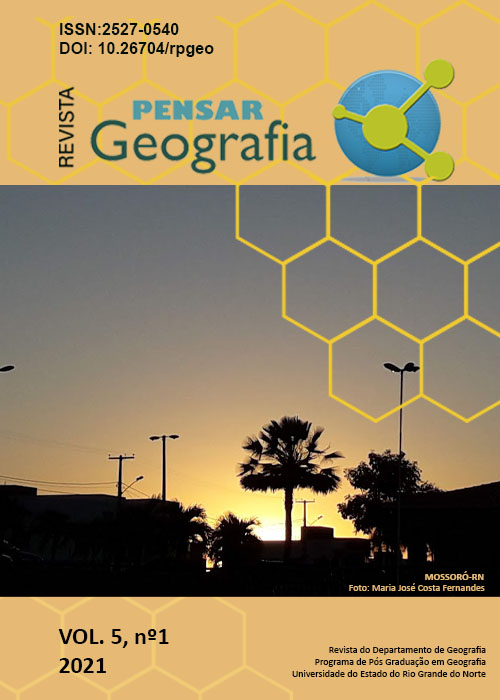Disseminação do COVID 19 na Região do Oeste Potiguar
DOI:
https://doi.org/10.26704/pgeo.v5i1.3214Keywords:
Saúde pública; Sistema de Informação Geográfica; Pandemia.Abstract
In Brazil, one of the countries most affected by the propagation of vírus Sars-CoV-2, health authorities and social segments in general still try to understand the trajectory and the way the pandemic spread in the territory. What is known, for sure, is that the expansion took place from the large centers to the interior of the country. However, it is necessary to study specific cases to better understand the variables that affect the spread of COVID-19, especially in the interior of northeast, whose majoruty of the municipalities, has na irregular water spply, and it doesn"™t even have a sewage collection and treatment system. This study aims to map the dissemination of confirmed cases of COVID-19 in the western region of the state of Rio Grande do Norte, between March and July 2020. For this, a database was built from epidemiological bulletins to monitor the numbers of those contaminated by COVID-19, whose source was the State Health Department of RN. Subsequently, mapping of spatial diffusion in the disease was performed using the software QGIS 3.4. Data analysis showed us that four months after the first case in the state, there was a total of 8,878 contaminated inhabitants in 62 municipalities in the western region potiguar. Some municipalities were more affected than others, showing geographical factors, such as proximity to regional centers and the presence of federal highways. The spatialization of COVID-19 data allowed an analysis of how the disease spread in this region in the Northeast.
Downloads
References
DIAS, G. H. et al. NOTA TÉCNICA COVID-19 No. 001/2020 – DGE/UERN. Disponível em https://www.researchgate.net/publication/342282019_Nota_Tecnica_Covid-19_N_0012020_DGEUERN Acesso em 18 de jan. de 2021
DIAS, G. H.; SOUZA, C. D. S.; BEZERRA, M. R.; PEIXOTO, F. S. Análise da distribuição espacial da covid-19 e subnotificação de casos novos e óbitos no estado do Rio Grande do Norte, Brasil. Revista Pensar Geografia, v. 3. P. 51-67, 2019.
ESTADO DO RIO GRANDE DO NORTE. Secretaria da Saúde Pública. Boletins Epidemiológicos. SESAP, 2020. Disponível em <http://www.saude.rn.gov.br/Conteudo.asp?TRAN=ITEM&TARG=223456&ACT=&PAGE=&PARM=&LBL=MAT%C9RIA> Acessado em 30 de junho de 2020.
FUNDAÇÃO OSVALDO CRUZ (FIOCRUZ). Monitora COVID-19: Nota Técnica 1, 2 de abril de 2020.
GOVERNO DO ESTADO DO RIO GRANDE DO NORTE. Decreto 29.742, de 04 de junho de 2020. Institui a política de isolamento social rígido para enfrentamento do novo coronavírus (COVID-19) no Estado do Rio Grande do Norte, impõe medidas de permanência domiciliar, de proteção de pessoas em grupo de risco e dá outras providências. Natal, RN, junho, 2020. Disponível em http://diariooficial.rn.gov.br/dei/dorn3/docview.aspx?id_jor=00000001&data=20200604&id_doc=685295. Acesso em 2021 de junho de 2020.
LAI, Chin-cheng; SHIHB, Tzu-Ping; KOC, Wen-Chien. Severe acute respiratory syndrome coronavirus 2 (SARS-Cov-2) and coronavirus disease-2019 (COVID-19): The epidemic and the challenges. International Journal of Antimicrobial Agents. Volume 55, Issue 3, March 2020, 105924.
LIMA, J. R. P. de A. et al. The vírus and socioeconomic inequality: Na agente-based model to simutale and assess the impacto f interventios to reduce the spread of COVID-19 in Rio de Janeiro, Brazil. Braz. J. Hea. Ver., Curitiba, v. 3, n. 2, p.647-3673 mar./apr. 2020. ISSN 2595-6825.
Organização Mundial de Saúde (OMS), 2020a. WHO Director-General's opening remarks at the media briefing on COVID-19 - 11 March 2020. Disponível no link https://www.who.int/dg/speeches/detail/who- director-general-s-opening-remarks-at-the-media-briefing-on-covid-19---11-march-2020 Acesso em 07 de junho de 2020.
PRADO, M.; BASTOS, L.; BATISTA, A.; ANTUNES, B.; BAIíO, F.; MAÇAÍRA, F. HAMACHER, S.; BOZZA, F.. Análise da subnotificação do número de casos confirmados da COVID-19 no Brasil. Núcleo de operação e Inteligência em Saúde (NOIS) – Nota técnica 7 – 11/04/2020.
SPOSITO, M. E. B.;GUIMARíES, R. B.. Por que a circulação de pessoas tem peso na difusão da pandemia, 26 mar, 2020. Disponível em: https://www2.unesp.br/portal#!/noticia/35626/porque-a-circulacao-de-pessoas-tem-peso-na-difusao-da-pandemia Acesso em 25 de agosto de 2020.
UFRN. Coronavirus RN, 2020. Laboratório de Inovação Tecnológica em Saúde. Disponível em <https://covid.lais.ufrn.br/> Acesso em 30 de junho de 2020







